These Rototillers Turn Hard-Packed Dirt into Nutrient-Rich Soil
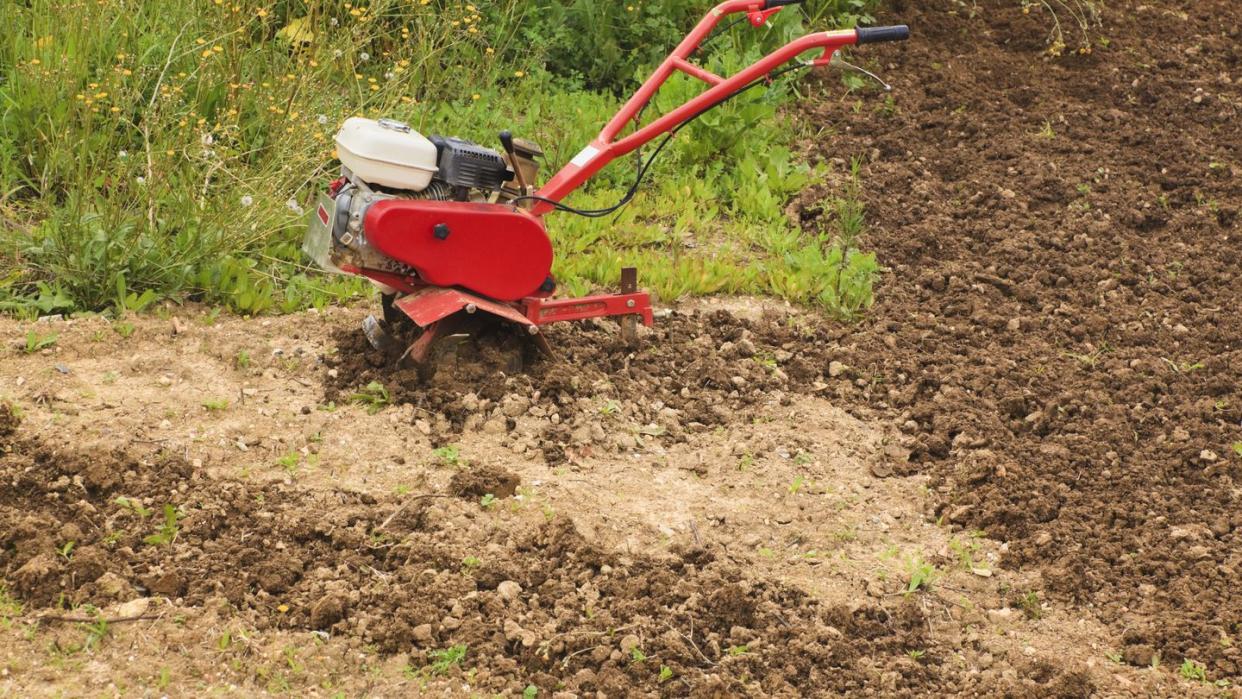
"Hearst Magazines and Yahoo may earn commission or revenue on some items through these links."
If you want to grow a thriving garden, you should probably till your soil before you plant. You can break up the earth with a shovel and a cultivator, which is a lot of work, or you can spare your back and purchase a rototiller, which uses rotating metal tines to cut into the ground, loosening the soil so vital nutrients can reach your plants’ roots.
Whether you’re setting up a veggie garden or preparing for seasonal landscaping, a rototiller will make the job faster and easier. There are large, gas-powered models that can dig into hard soil and till large swaths of ground, as well as lightweight, handheld, battery-powered cultivators for weeding and mixing compost or fertilizer into existing garden beds. With so many types of rototillers to choose from, finding the right one can be a challenge. Luckily I’ve tilled many a garden and can help you determine which rototiller is the best for you.
More Yard Machines: Best Riding Lawn Mowers ● Popular Mechanics 2023 Yard & Garden Awards ● Best Cement Mixers
Best Rototillers
Best Overall: Mantis 7940 4-Cycle Plus Tiller
Best Value: Earthwise TC70025 7.5-Inch 2.5-Amp Corded Electric Tiller
Most Versatile: Troy-Bilt TBC304 Garden Cultivator
Best Battery Powered: Ryobi 40V HP Brushless Whisper Series 16-Inch Front Tine Tiller
Best Coverage: Tazz 2-in-1 Tiller Cultivator
The Expert: I’m a freelance writer who has written about landscaping, home improvement, gardening, and home security for publications like Popular Mechanics, Bob Vila, Angi, U.S. News and World Report, Switchful, and Futurism. As an avid gardener, I’ve used large gas-powered rototillers to establish new landscaping beds and several smaller cultivators to work soil for mixing compost and fertilizer into gardens.
What to Consider
Before picking the best rototiller, it helps to understand what they do and how they work. Rototillers use either gas engines or electric motors to rotate a set of steel tines that churn the soil beneath it. Two wheels support the engine and tines, allowing the tiller to roll forward.
Some rototillers specifically break new ground, while others function as hybrid tiller-cultivators that can break ground, refresh previously tilled soil beds, and mix up loose soil.
Engine/Motor
Gas Powered
Most rototillers are powered by gas engines, which provide the torque necessary to break up hard, untilled earth or clay.
Gas-powered rototillers split up into two broad sub-categories: Large models with rear-facing tines for larger jobs with hard soil, and smaller “mini-tillers” for cultivating and weeding existing gardens and landscaping beds. While gas-powered rototillers offer the most power, it’s worth keeping in mind that they are usually louder, heavier, and require more maintenance than an electric alternative.
Battery Powered
Wireless electric rototillers are generally cheaper than gas-powered rototillers and require less maintenance. Charging a lithium-ion battery is easier than filling a gas tank, and electric motors don’t need oil changes.
Battery life and power are generally an issue, though: Rototillers require a lot of power to run, so don’t expect to get more than about 40 minutes of run time on a single charge. If you buy extra rechargeable batteries to keep it running longer, a wireless electric model can cost just as much as a gas-powered model.
Battery-powered rototillers also don’t produce the same tilling power as gas-powered models because they have less torque, limiting them to breaking up loose soil in existing gardens and beds.
Corded Electric
Since battery life can be an issue, corded electric rototillers are a great option if you have an outlet on the outside of your home. Like battery-powered models, they’re easy to start and require very little maintenance. Since they’re lightweight and compact, you’ll have an easier time steering them through small garden beds and storing them when you’re done.
Corded electric rototillers are the most affordable of the three options, but they’re also the least powerful. Limited by the output of your outlet, they simply don’t produce as much tilling power as a gas-powered model. The power cord also limits their range and can get in the way as you work. Ultimately, we’d only recommend them for small jobs, such as cultivating a backyard vegetable garden.
Weight
While rototillers are considered heavy machinery, you should opt for one that’s light enough for you to maneuver around a soil bed. Small handheld tillers weigh around five pounds, making them the easiest to transport and handle. Small gas mini-tillers weigh around 25 to 50 pounds, and large rear-tine tillers often weigh well over 100 pounds.
Tines
The spiked metal pieces of the rototiller that break into the soil and mix it up are called tines. The more tines your rototiller has, the easier it will be to break up dense soil. Some rototillers have reversible tines. One side is made for digging into untilled soil, and the other side works better for cultivating gardens and beds.
Front-tine rototillers are nimble enough to work around existing plants, so they’re ideal for breaking up ground in established gardens and landscaped areas. Rear-tine rototillers are much larger and more powerful than their front-tine counterparts. While they’re more difficult to maneuver and fit into smaller spaces, their power makes them ideal for breaking new ground to create new landscaping or garden beds.
Cultivating Width
A rototiller’s cultivating width indicates the size of the swath of ground it can dig up with each pass. The wider the tiller, the more soil you turn over with each step. Rototillers with narrow cultivating widths are generally easier to maneuver, which makes them a better choice for smaller plots of land.
Rototiller cultivating widths range from 6 inches for smaller tillers up to 17 inches for a large rear-tine model. Some tillers feature removable tines that allow you to narrow the cultivating width, which is worth looking for if you’re planning to use one to cultivate large beds and tight garden rows.
Cultivating Depth
Most rototillers also allow you to adjust how deeply the tines dig into the earth—anywhere from 6 inches for smaller tillers up to 11 inches for larger models. You’ll want to till a new vegetable garden to a depth of 6 to 10 inches, and existing gardens to a depth of 4 to 8 inches, so we recommend avid gardeners look for adjustable tillers.
How We Selected
As someone who spends the warmer months of the year planting and nurturing a sizable vegetable garden, I’m familiar with the ins and outs of rototillers. I’ve used large rear-tine models to establish new garden beds and regularly use a front-tine rototiller for cultivating the soil and mixing in compost prior to spring planting. Since rototillers come in a broad range of sizes, I included a variety of different models to suit gardens and flower beds both large and small.
Since I haven't been able to test all of the models on our list, I conducted hours of research, comparing specs, scouring dozens of user reviews, and recalling models I’ve used myself to help inform my selections. My final picks include small, lightweight rototillers for cultivating, front-tine rototillers for working soil in existing gardens, and large rear-tine models for breaking new ground.
7940 4-Cycle Plus Tiller
The Mantis 7940 is powerful and lightweight for a gas-powered rototiller. With a heavy-duty 25cc engine and 9-inch cultivating width, it’s suitable for plowing patches of untilled earth, while still being nimble enough to cultivate and weed through narrow rows in your garden. It also digs deeper than most mini tillers thanks to its 10 inch digging depth.
At 24 pounds, it’s easy to move the Mantis from shed to garden and you won’t need to wrestle with it as you till. When you put it away, the handles fold down so you can store it in tight spots.
It also has reversible tines, giving you distinct options for tilling, versus weeding and cultivating. Cushioned ergonomic handles keep your hands comfortable for longer jobs. Its deeper-than-average tilling depth, mid-sized cultivating width, powerful gas engine, and light overall weight make it a great all-around tiller whether you’re plowing a new bed or cultivating an existing garden.
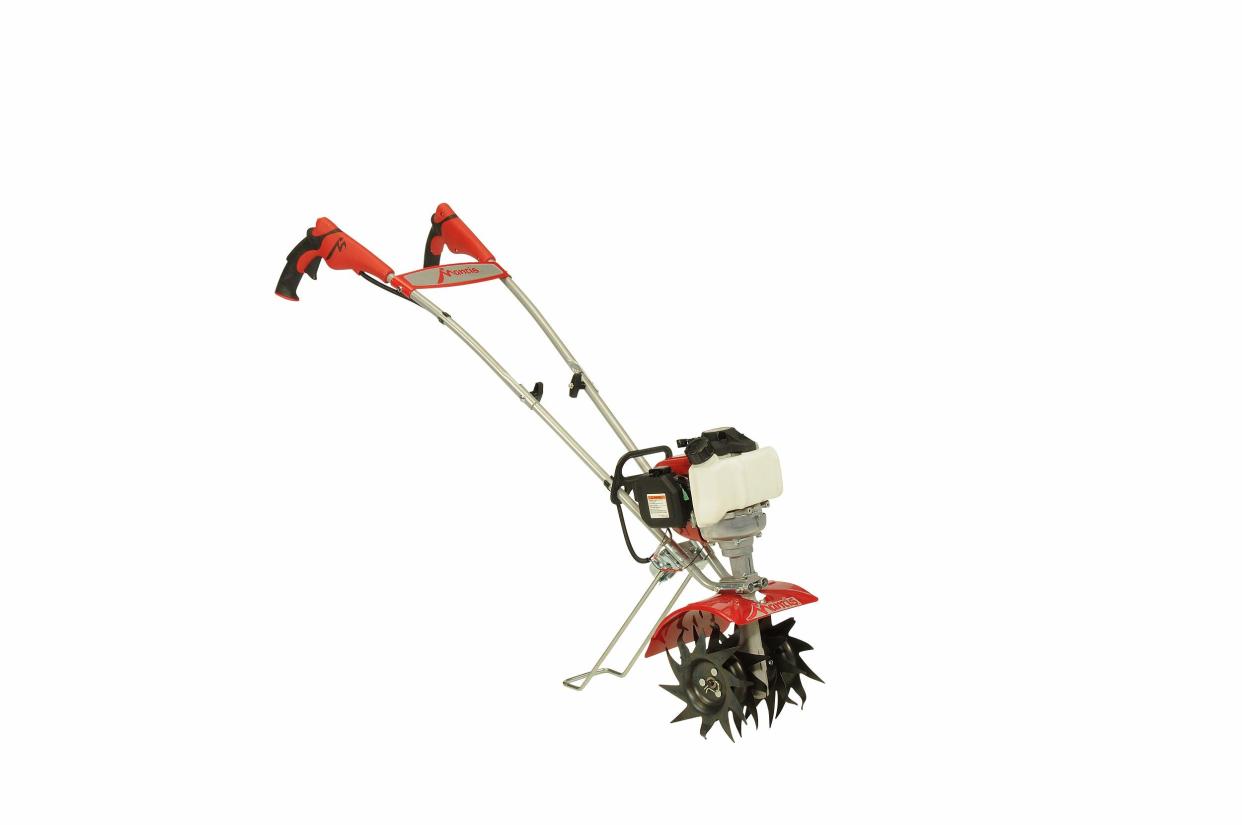
7940 4-Cycle Plus Tiller
amazon.com
$489.99
TC70025 7.5-Inch 2.5-Amp Corded Electric Tiller
If you only have a small garden or flower bed to cultivate, then it doesn’t make sense to spend hundreds on a new rototiller. This corded electric model from Earthwise will get the job done at a fraction of what other rototillers cost.
It can till a path of soil up to 7.5 inches wide and 6 inches deep, so it’s suitable for smaller gardens. And while it’s not powerful enough to break new ground, it is a good option for cultivating the looser soil found in existing gardens and flower beds.
At just nine pounds, the Earthwise rototiller is also easier to maneuver around a garden bed than larger rototillers that can weigh upwards of 20 to 30 pounds. With its trigger style grip, it’s more nimble than larger rototillers that use a handlebar, so it’s nimble enough to cultivate and weed around existing plantings.
If you have a smaller garden to prep for spring plantings, the Earthwise is a great budget-minded choice.
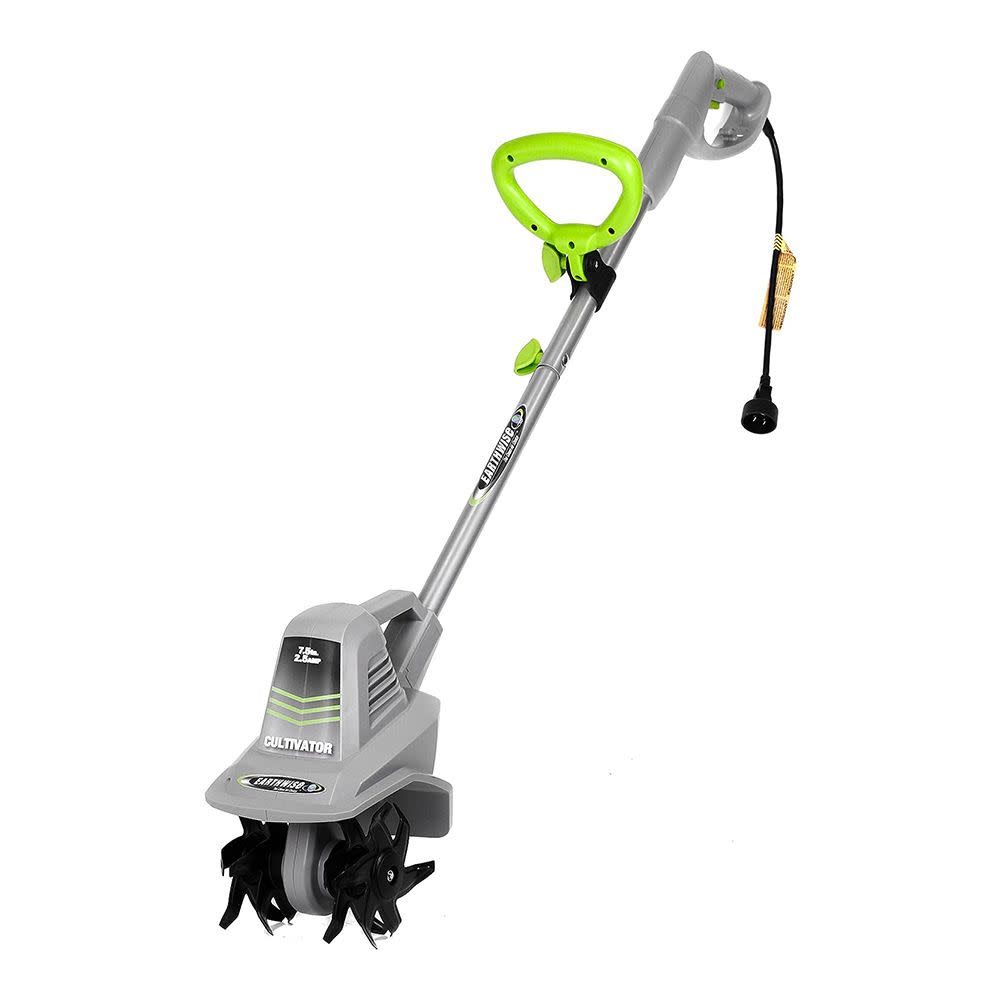
TC70025 7.5-Inch 2.5-Amp Corded Electric Tiller
amazon.com
$104.99
TBC304 Garden Cultivator
With its ability to change cultivating widths, the Troy-Bilt TBC304 can chew through larger swaths of soil or break up ground around existing plants. You can adjust the width of the cultivator from 6 inches for precise tiling around plants in smaller gardens, up to an extremely wide 12 inches for breaking up open ground.
A 30cc engine provides ample power for its six tines, and a variable speed control allows you to adjust the tine speed by how hard you squeeze the handle-mounted throttle. Given its size and power, the TBC304 is comparatively light at 33 pounds for easy maneuvering and transport from storage to garden.
The adjustable width feature comes with some tradeoffs, though. Its max till depth is only 6 inches–versus the 8 inches of most rototillers–and there’s no way to adjust the height of the back wheels to control your depth. Still, given its light weight and useful adjustability features, the TBC204 is a great rototiller for those who need a machine that can cover a lot of ground or work around existing landscaping.
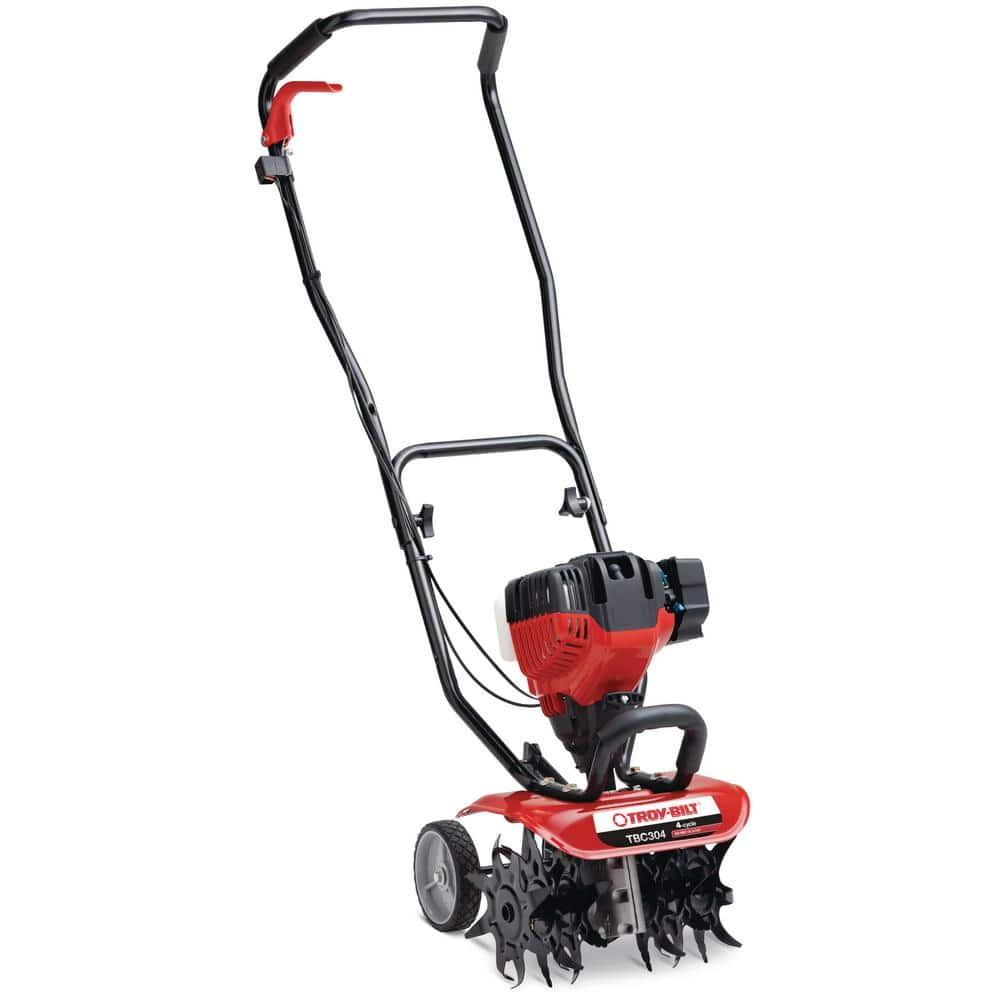
TBC304 Garden Cultivator
homedepot.com
$279.99
40V HP Brushless Whisper Series 16-Inch Front Tine Tiller
Ryobi’s Brushless Whisper Series rototiller gives you the easy-start and low maintenance design of an electric rototiller without the limitations of a power cord. Its brushless motor is powered by a large 40-volt rechargeable lithium-ion battery.
While it doesn’t match the power of gas-powered models, it offers an extremely wide 16-inch maximum cultivating width and digs down to 8 inches. It’s also much quieter than its gas-powered counterparts.
It also offers both adjustable cultivating width and depth. You can narrow its six tines down to as little as 11 inches for a wide, but controlled approach, then spread out to 16 inches to churn large open areas. There are also three depth settings, so you can lightly refresh the soil or dig deep for a new garden.
Like all battery-powered yard machines, the Whisper Series has its limitations. It costs about the same as gas-powered models, but you’ll only get 20 to 40 minutes out of the battery before you need to charge it, which takes a much longer 90 minutes. If you’re only tilling a relatively small space, it’s a very convenient choice.
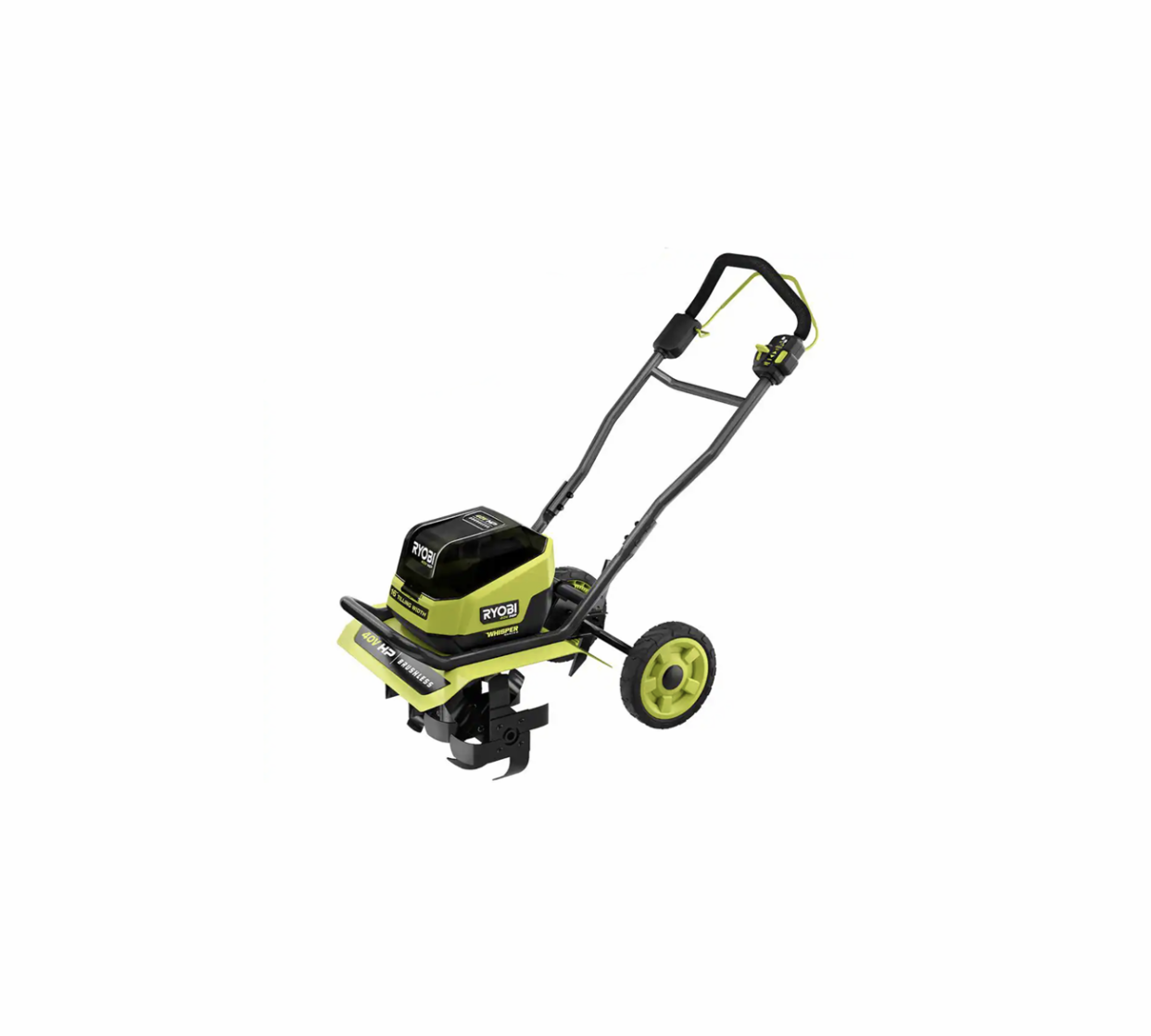
40V HP Brushless Whisper Series 16-Inch Front Tine Tiller
homedepot.com
$599.00
2-in-1 Tiller Cultivator
If you need to till a garden that spans a large area, then consider the Tazz 2-in-1 tiller. It comes equipped with a large 79cc engine that powers four large tines capable of razing a 21-inch wide swath of earth, driving 11 inches deep. That’s far greater than other front-end tillers that typically give you about half that width and around 6 to 8 inches of cultivating depth.
While it’s made for large soil beds, it features some adjustability, spreading to 11, 16, or 21 inches wide and four different depths to suit the size garden you're cultivating.
While the Tazz gives you all the power you could ask for, it also demands a lot from you. Weighing in at more than 85 pounds, it’s a bear to maneuver. Given its large size and weight, the Tazz is best reserved for tilling medium-size swaths of hard ground without too many living plants. You really want to minimize the number of times you have to move it.
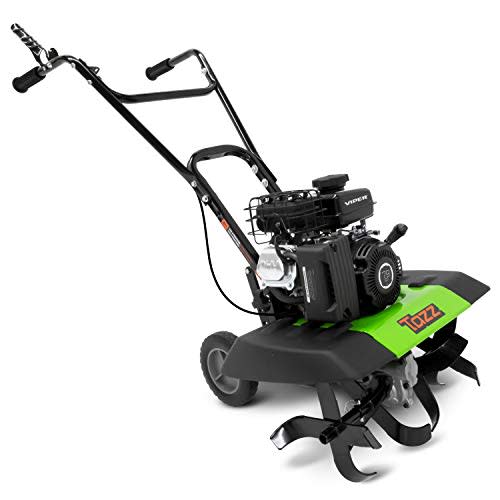
2-in-1 Tiller Cultivator
amazon.com
$399.99
TC70016 13.5-Amp 16-Inch Electric Rototiller
Going for a corded electric rototiller is often an easy way to save a little money if you have an outlet near an existing garden or landscaping element. The Earthwise TC70016 offers more bang for your buck with a 13.5-amp motor that powers a broad 16-inch cultivating width, and 8-inch depth.
At 29 pounds, it’s also light enough to move from storage shed or garage to work site and maneuver around tighter spaces. You can also remove the two outer tines, narrowing the cultivating width down to 11 inches.
It also offers plenty of convenience-minded features, including push-button start, a cushioned handlebar that folds up for easy storage, and a large hood that protects you from thrown dirt and rocks while you till. So long as it can reach your garden, it’s a solid, price-conscious choice.
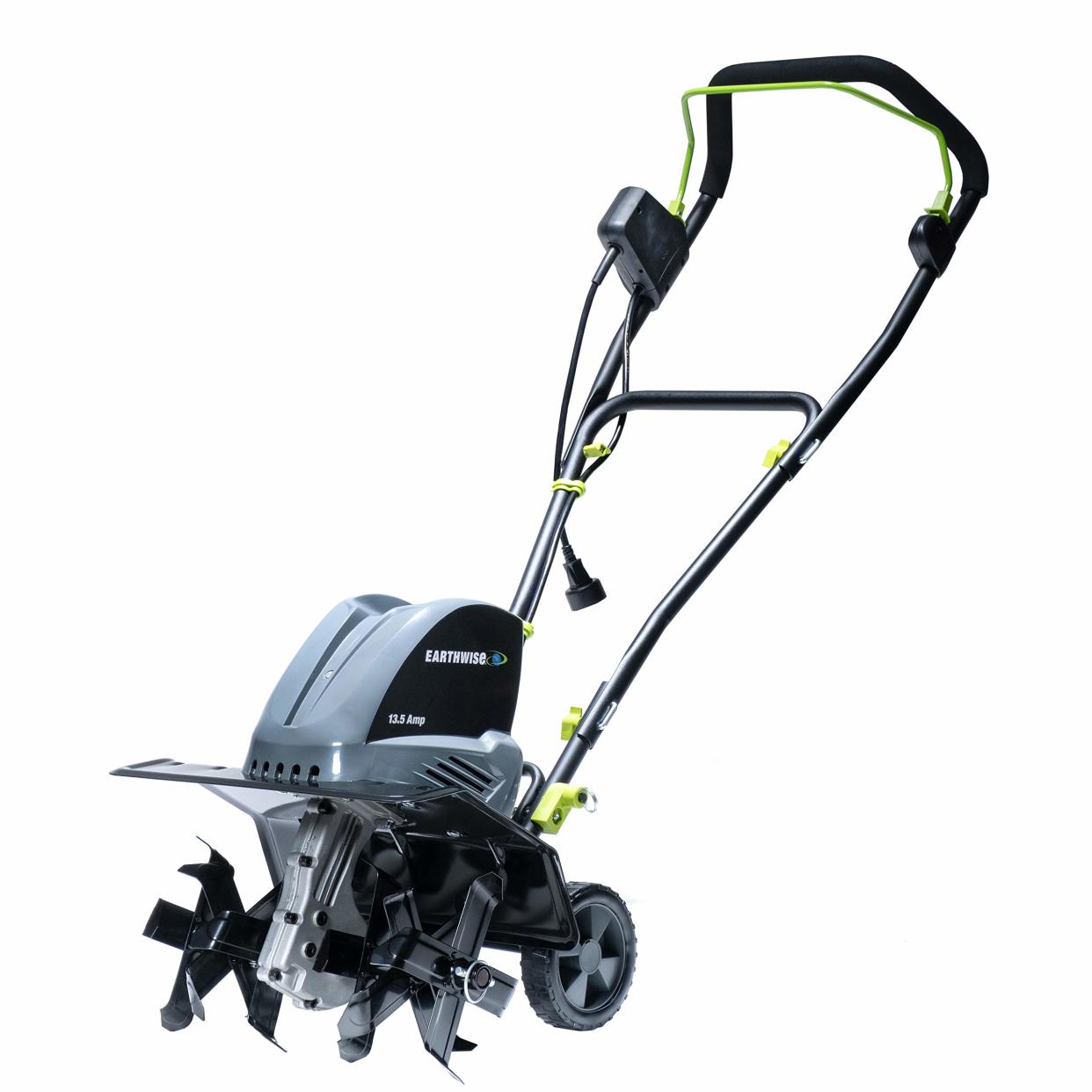
TC70016 13.5-Amp 16-Inch Electric Rototiller
amazon.com
$179.99
Pioneer Rear Tine Tiller
Tilling through hard soil and dense turf requires the most powerful rear-tine tiller you can find. We recommend the Earthquake Pioneer, which features a large 99cc engine that’s capable of tearing up patches of dirt 17 inches wide and 9 inches deep. It also allows you to switch between two tilling modes–one for blasting through untilled earth and another for mixing tilled soil.
There are also features that make it easier to maintain and use. Since it weighs a massive 160 pounds, we really appreciate that it features airless tires so you can wheel it around.
Still, it isn’t easy to maneuver in the ground, so make sure you use it in large soil beds without any living plants. This is professional-grade gear and the price reflects that, but there’s no better option if the soil needs a lot of work.
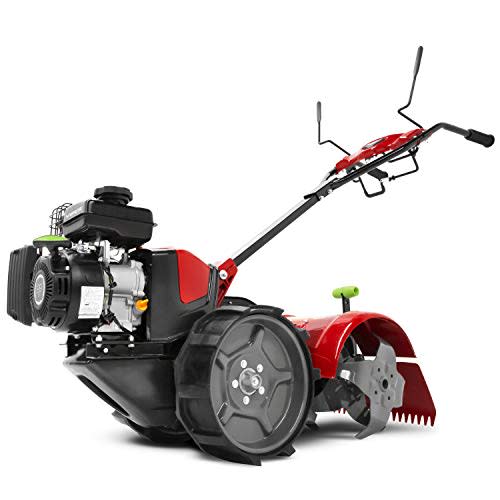
Pioneer Rear Tine Tiller
amazon.com
$1199.00
20V Max Cordless Garden Cultivator
With its lightweight design, this Black+Decker cordless tiller is easy to transport, even remote garden beds. It weighs just 11 pounds and runs off a rechargeable 20-volt lithium-ion battery. Unlike traditional tillers that use rotating tines, this cultivator has two tines that point downward and oscillate to stir the ground, cultivating a patch that’s 7 inches wide and 4 inches deep.
It may not be as powerful as its heavier and bulkier cousins, it can cover up to 325 square feet of planting beds on a single charge, making it very easy to maintain small gardens.
And since it’s so light and small, I think it’s perfect for tending to soil near living flowers and vegetable plants in existing gardens. It also has a telescoping pole, which you can adjust to suit your height.
One thing worth noting: The 20V Max is part of Black+Decker’s Powerconnect battery system, which uses interchangeable batteries for many yard machines and appliances. If you already have a 20V Powerconnect battery (or two), you save some money by purchasing the tiller without a battery.
If you don’t already have a Powerconnect tool (or want another battery), make sure you’re buying the version that comes with a battery and charger.
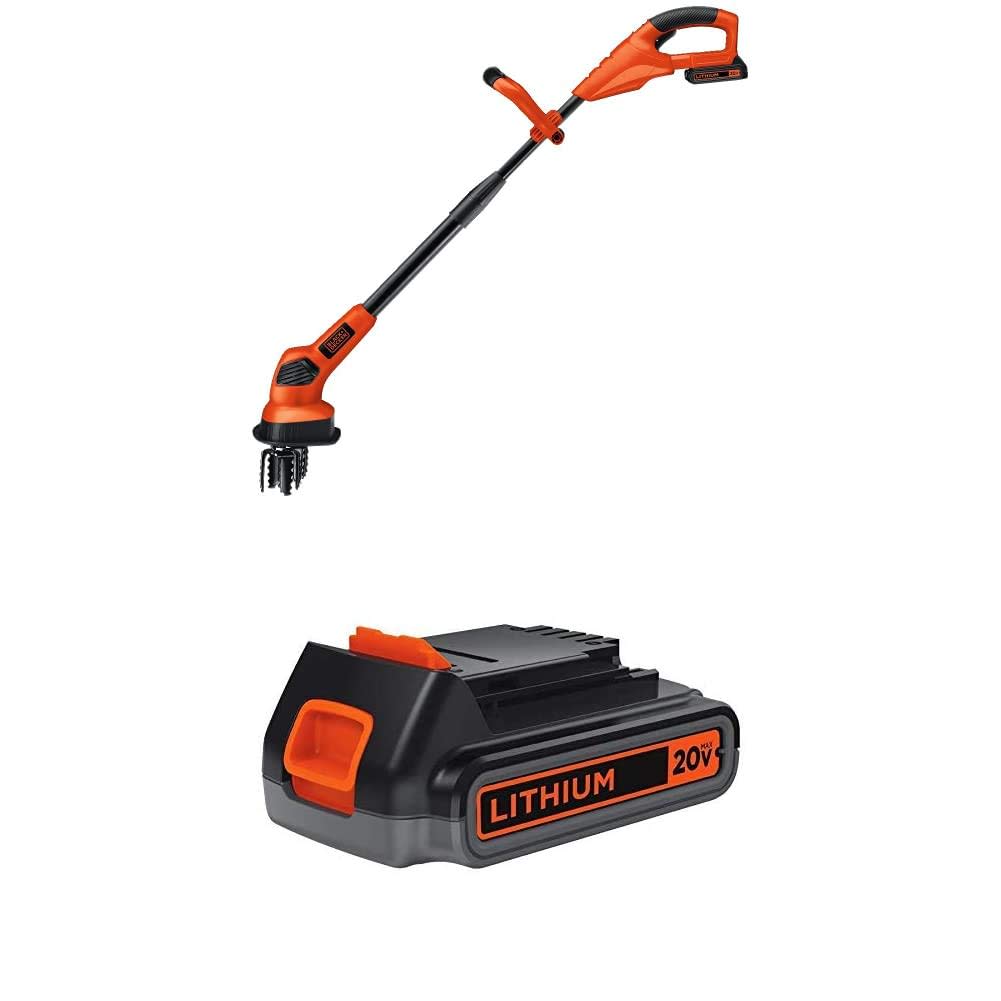
20V Max Cordless Garden Cultivator
amazon.com
$164.58
Electric Tiller-Cultivator
This tiller uses two rechargeable 20-volt lithium ion batteries to power an uncharacteristically large 500-watt brushless motor, which can spin its four tines at 230 RPMs to dig up a 14-inch wide, 7-inch deep patch of soil.
That’s much larger than you’ll find on most battery-powered models—a great option if you need to work dry, hard ground, but don’t want gas-powered yard machines. And, even with that wide cultivating width, it’s still relatively light at about 24 pounds.
While the battery-powered design makes the SuperHandy easy to start and very light, you are still very limited by its battery life. You’ll only get 40 minutes of battery life, even with the dual batteries.
What’s worse, it only comes with a single battery charger for two batteries, so it will take several hours to power up between uses.
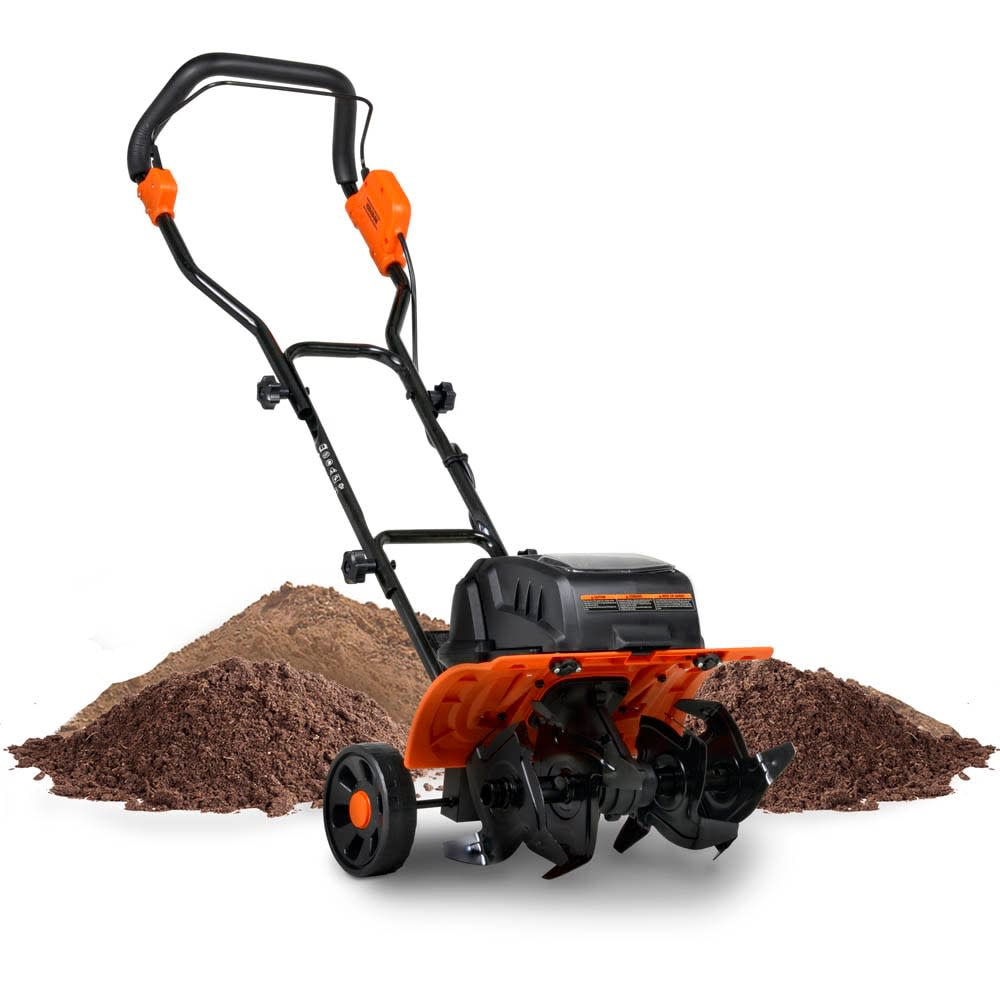
Electric Tiller-Cultivator
lowes.com
$194.00
22-inch 4-Stroke Gas Garden Front-Tine Tiller
Champion has a reputation for making generators and outdoor yard equipment that offer tremendous bang for the buck, and this front-tine rototiller is no exception. It comes equipped with a massive 212cc engine—one of the most powerful front-tine tillers out there— yet it costs the same as machines with much smaller engines.
That beefy engine makes it capable of chewing through unbroken ground to create new flower beds and vegetable gardens. It can dig to a max depth of 14 inches, ideal for creating deeper beds for plantings.
It’s versatile too. The Champion rototiller carves a wide 22-inch path for larger gardens and can also be narrowed down to 16 inches for smaller jobs. There are also tines that go in forward and reverse for easy maneuvering, though it still can be a challenge to move at 119 pounds.
If you don’t mind the weight, the Champion’s power and broad tilling width make a great choice for those looking to break ground on a new garden or landscaping bed.
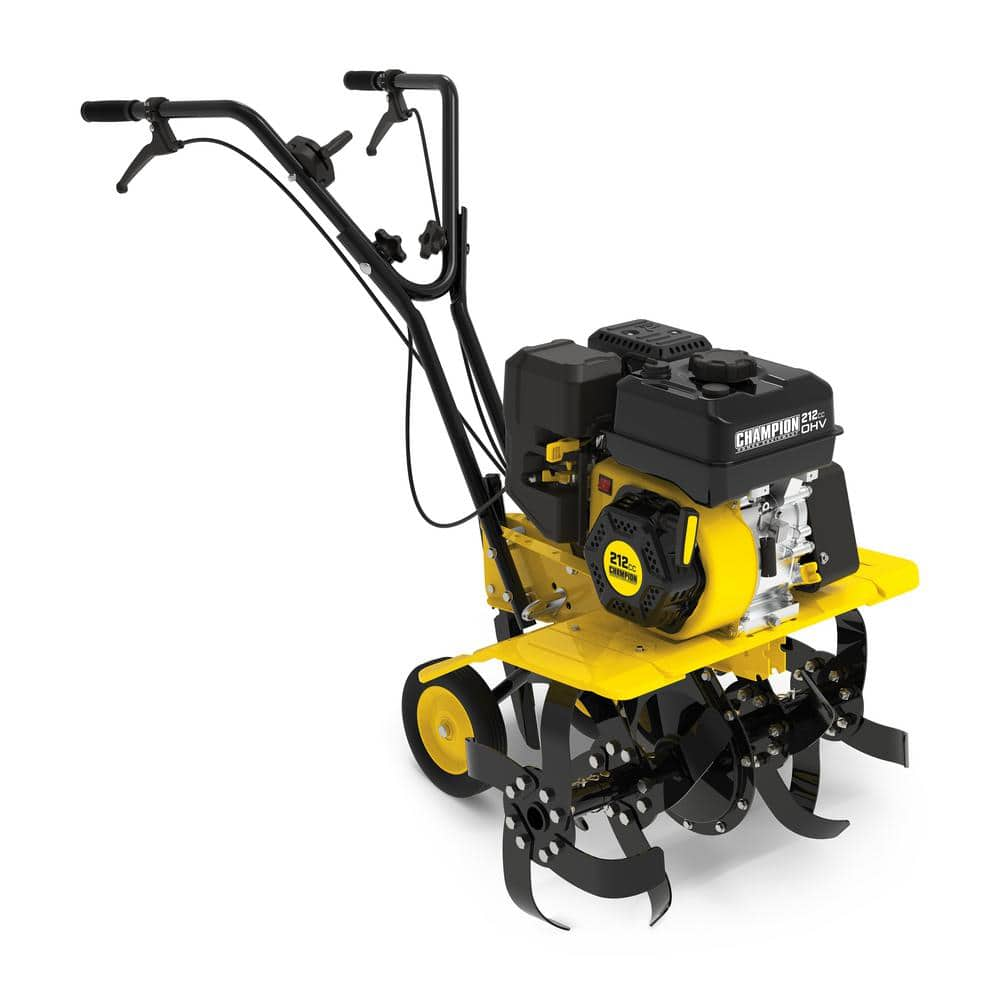
22-inch 4-Stroke Gas Garden Front-Tine Tiller
homedepot.com
$499.00
649680 9-inch Front-Tine Tiller
Honda’s known for making top quality yard equipment and this rototiller is a great example of that. This rototiller is built to take a beating with commercial grade construction and a metal guard that protects the engine. Its 25cc engine is ideal for breaking up the soil in existing gardens and landscaping beds but lacks the power to churn through new ground.
It’s also customizable to suit varying size jobs. It can till to a max width of 9 inches for larger gardens. For smaller spaces, you can remove the outer tines to narrow that width to 6 inches. The tilling depth is also adjustable and you can remove the drag bar and the rear wheels to convert the tiller into a cultivator for weeding around plantings. If you want a versatile tiller with excellent build quality, this is the one.

649680 9-inch Front-Tine Tiller
lowes.com
$449.00
Q+A With Lawn Expert Tony Carrick
PM: What’s the difference between a tiller and a cultivator?
TC: As you may have noticed in this guide, experts and manufacturers use the terms “tiller,” “rototiller,” and “cultivator” interchangeably. That can be confusing, especially since they technically refer to different tools.
Tillers (or rototillers) have powerful engines and tines that allow them to break up untilled earth and soil. Cultivators are designed to chop up weeds or mix compost in an existing garden bed and are hence smaller and less powerful. Most modern cultivators are powerful enough to work as a tiller in most gardening conditions, so the terms have merged. There are some tillers that are too simply too large to work as cultivators, though.
PM: Should I buy a front-tine or rear-tine tiller?
TC: It comes down to what kind of soil you need to till. Rear-tine tillers usually have larger engines, which allow them to turn over wider, deeper patches in the soil. Front-tine tillers are smaller and easier to maneuver, so they’re suitable for cultivating existing gardens or breaking up softer earth.
PM: How often should I till my garden bed?
TC: First, you should always till a new garden or landscaping bed before planting to loosen up the soil. You should use the tiller on any area where you plan to plant new seeds to mix in compost and grind up weeds just before planting.
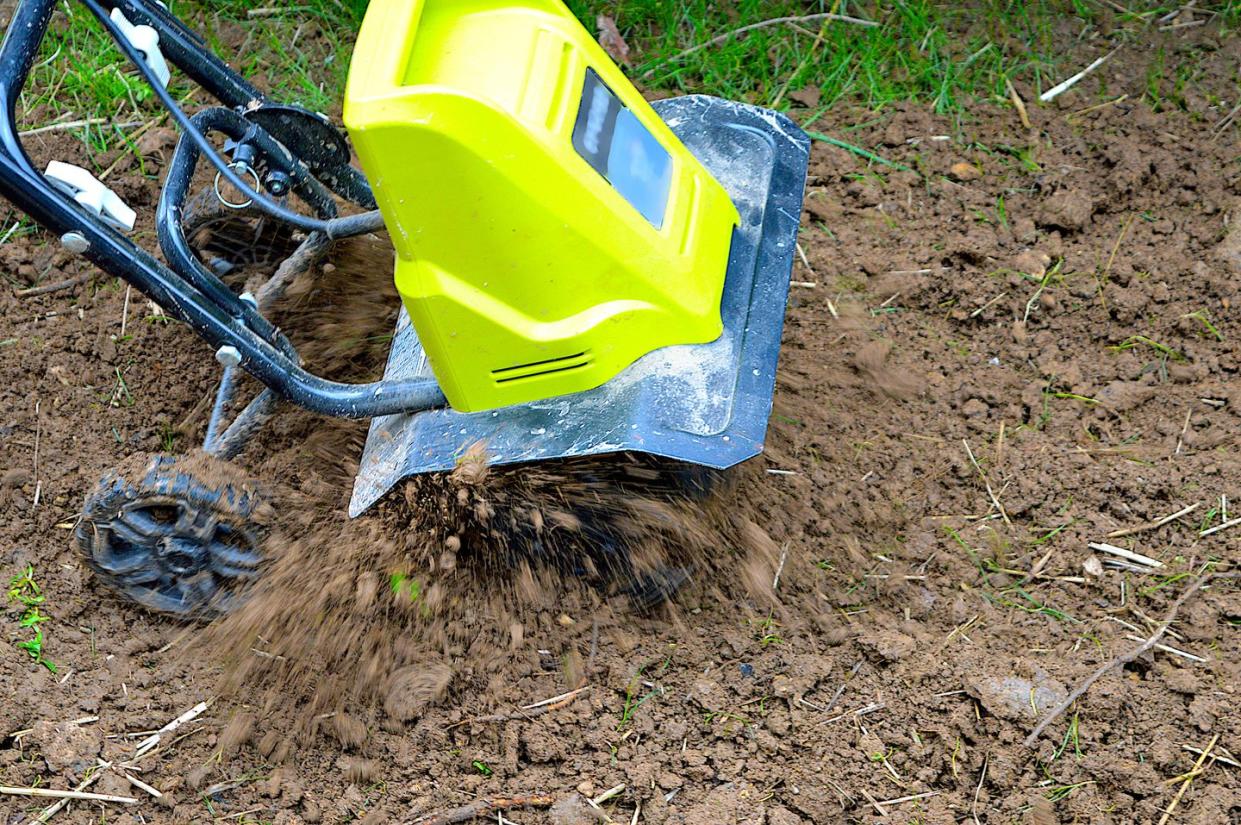
You Might Also Like
